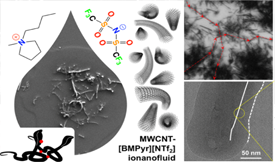
High-Performance Ionanofluids from Subzipped Carbon Nanotube Networks
Marzena Dzida, Sławomir Boncel, Bertrand Jóźwiak, Heather F. Greer, Mateusz Dulski, Łukasz Scheller, Adrian Golba, Rafał Flamholc, Grzegorz Dzido, Justyna Dziadosz, Anna Kolanowska, Rafał Jędrysiak, Anna Blacha, Krzysztof Cwynar, Edward Zorębski, Carlos E.S. Bernardes, Maria J.V. Lourenço, Carlos Nieto de Castro
ACS Appl. Mater. Interfaces 2022, 14, 50836−50848.
Abstract
Investments in the transfer and storage of thermal energy along with renewable energy sources strengthen health and economic infrastructure. These factors intensify energy diversification and the more rapid post-COVID recovery of economies. Ionanofluids (INFs) composed of long multiwalled carbon nanotubes (MWCNTs) rich in sp2-hybridized atoms and ionic liquids (ILs) display excellent thermal conductivity enhancement with respect to the pure IL, high thermal stability, and attractive rheology. However, the influence of the morphology, physicochemistry of nanoparticles and the IL−nanostructure interactions on the mechanism of heat transfer and rheological properties of INFs remain unidentified. Here, we show that intertube nanolayer coalescence, supported by 1D geometry assembly, leads to the subzipping of MWCNT bundles and formation of thermal bridges toward 3D networks in the whole INF volume. We identified stable networks of straight and bent MWCNTs separated by a layer of ions at the junctions. We found that the interactions between the ultrasonication-induced breaking nanotubes and the cations were covalent in nature. Furthermore, we found that the ionic layer imposed by close MWCNT surfaces favored enrichment of the cis conformer of the bis(trifluoromethylsulfonyl)imide anion. Our results demonstrate how the molecular perfection of the MWCNT structure with its supramolecular arrangement affects the extraordinary thermal conductivity enhancement of INFs. Thus, we gave the realistic description of the interactions at the IL−CNT interface with its (super)structure and chemistry as well as the molecular structure of the continuous phase. We anticipate our results to be a starting point for more complex studies on the supramolecular zipping mechanism. For example, ionically functionalized MWCNTs toward polyionic systems - of projected and controlled nanolayers - could enable the design of even more efficient heattransfer fluids and miniaturization of flexible electronics.
Return Previous Next